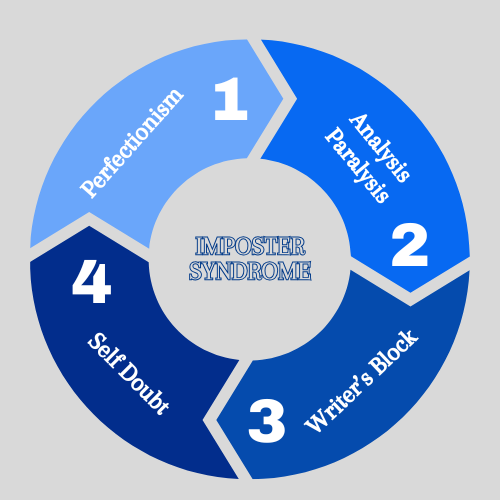Break Free from Imposter Syndrome
And do what you are meant to do which is Write Your Damn Screenplay
MCH
2/10/20254 min read


Imposter Syndrome. That sneaky, joy-stealing bastard.
If you’re a screenwriter—whether you’re just starting out or deep in the trenches—you’ve likely heard that voice whispering, "Who do you think you are?" or "This script will never be as good as (insert Oscar-winning screenplay here)."
And that voice? It’s lying to you.
So let’s expose Imposter Syndrome for what it really is—a cycle of self-doubt, perfectionism, and creative paralysis that keeps you from writing the story only you can tell. Because the truth is, no one else sees the world like you do.
But before we get to the solution, let’s break down how writers get trapped in this cycle in the first place.
It usually goes something like this:
👉 “This has to be perfect.” (Perfectionism) – You overthink every scene, every line of dialogue. From page one, you’re convinced your script needs to be flawless. So you stress over every detail before you even write a word.
👉 “I need to figure out every single detail before I start.” (Analysis Paralysis) – Instead of writing, you spiral into endless research, tweaking your outline, or searching for the “right” way to tell your story.
👉 “I can’t seem to write anything at all.” (Writer’s Block) – Because of all that pressure, the blank page now feels like a monster you can’t face. So you don’t.
👉 “Maybe I’m not cut out for this.” (Self-Doubt) – You start questioning yourself, comparing your messy draft to your screenwriting heroes' final, polished scripts.
👉 “I’m a fraud.” (Full-blown Imposter Syndrome) – You convince yourself you’re not a “real” writer, and the idea of finishing your screenplay feels impossible.
Sound familiar? Yeah. Welcome to the club. But here’s how you break the cycle.
The Cycle of Imposter Syndrome
Step 1: Trust in the Story You’re Telling
Your idea was exciting enough to make you want to write it—so don’t let fear kill that spark.
We get so wrapped up in trying to write the perfect screenplay that we forget why we started in the first place. And that initial spark? That’s everything. That’s what makes storytelling powerful.
Think about how you tell a great story at a campfire. 🔥
You don’t stop mid-sentence to analyze the B-story. You don’t map out the character’s backstory before getting to the good part. You just tell the damn story.
That’s how you should approach your first draft.
This is why I teach The Fast Draft Method—because when you strip storytelling down to its essentials, you stop overcomplicating the process. Your first draft isn’t about perfection—it’s about momentum.
Step 2: Forget Originality—Focus on Unique
Many writers get stuck because they’re terrified of not being original.
Guess what? There is no such thing as an original story.
Every story you love—every single one—has been told before. Homer wrote two of them. (The Iliad and The Odyssey.)
But that doesn’t mean your screenplay won’t be unique.
Because you bring something to the table that no one else can—your perspective, your voice, your experiences. That’s what makes your script stand out. Not some magical, never-before-seen plot device.
So take the pressure off. You don’t need to reinvent storytelling. You just need to tell a damn good story your way.
Step 3: Stop Comparing Yourself to Finished Movies
Here’s one of the biggest limiting beliefs that keeps screenwriters stuck:
"My script will never be as good as (insert famous movie here)."
Of course, it won’t—because you’re comparing your first draft to a finished film.
That Oscar-winning screenplay? It went through multiple drafts, rewrites, table reads, studio notes, director’s changes, and editing. The movie version you see on screen is the last draft.
Your first draft isn’t supposed to look like that. It’s supposed to be a mess. It’s supposed to be ugly because that’s how writing works.
Step 4: Write a Plot-Based Draft First
Stop trying to solve everything in one draft. You don’t need to figure out theme, subtext, and character nuance immediately. That’s like trying to decorate a house before you’ve built the foundation.
Instead, start with a plot-based draft.
👉 What happens in your story?
👉 Why does it matter?
👉 What are the big moments (Beginning, Middle, End)?
Once you have that, you have a screenplay.
Everything else—dialogue, theme, character depth—can be refined in later drafts.
Step 5: Finished is ALWAYS Better Than Perfect
You can’t rewrite something that doesn’t exist. You can’t get feedback on a blank page. And no producer, director, or actor will read a script that isn’t finished.
Perfect doesn’t exist. But finished does.
Even the best films started as rough drafts. Even the greatest screenwriters turn in pages that are less than brilliant. That’s what rewriting is for.
So, let go of perfectionism and focus on getting to the end. Because once you have a complete script, that’s when the real work (and the real fun) begins.
Step 6: Screenwriting is a Team Sport
You can’t rewrite something that doesn’t exist. You can’t get feedback on a blank page. And no producer, director, or actor will read a script that isn’t finished.
Perfect doesn’t exist. But finished does.
Even the best films started as rough drafts. Even the greatest screenwriters turn in pages that are less than brilliant. That’s what rewriting is for.
So, let go of perfectionism and focus on getting to the end. Because once you have a complete script, that’s when the real work (and the real fun) begins.
Your Story Matters
One of the biggest lies Imposter Syndrome tells you is:
"Nobody cares what I have to say."
That’s bullshit.
There is an audience for everything.
Think about the weirdest, most random movie you’ve ever seen. Guess what? Somebody watched it. Somebody loved it.
If you have a story burning inside you, there’s someone out there who needs to hear it. But you’ll never reach them if you don’t write it.
So stop waiting. Stop doubting. Stop letting fear keep you from finishing your script.
Want a Deeper Dive Into Screenwriting?
If you’re tired of overthinking every scene and want to learn a faster, more effective way to write your screenplay, check out The Fast Draft Method. My approach to screenwriting strips away the noise and helps you confidently write your script.
👉 Access my screenwriting secrets here
Because, at the end of the day, the only way to become a screenwriter is to write the damn script.
Happy writing, friends. 🚀🎬


© Copyright 2024 Fast Draft Inc. All Rights Reserved | Website by: Darling Design
